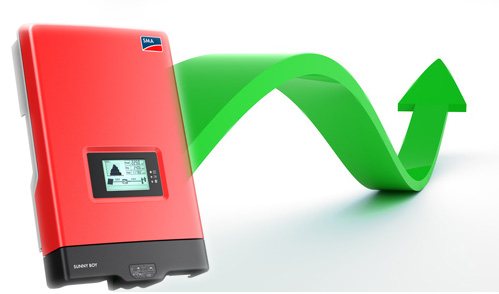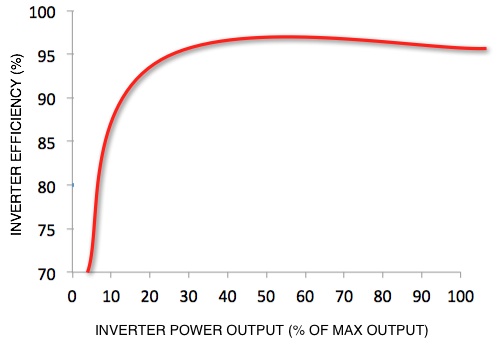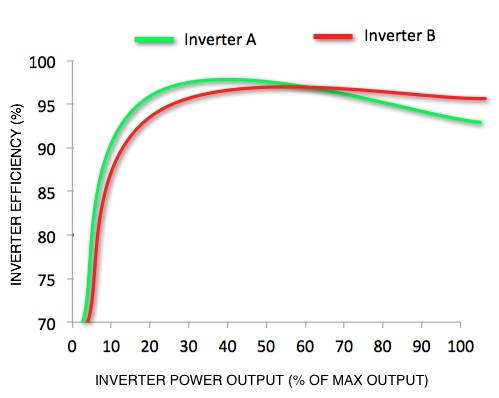In my last blog post I explained how to find an inverter’s real-world efficiency instead of relying on the inverter manufacturer’s numbers.
The CEC or European Efficiency numbers that I talked about are a much better number to use when comparing solar inverters. And for most people they will be all you need. However if you really want to understand how your solar system is going to perform then you should also look at the inverter’s “efficiency curve”.
Your inverter does not simply have one efficiency that it always operates at. The efficiency of your inverter will depend on two minor factors and one major factor.
The 2 minor factors are:
1) The ambient temperature of the inverter. The hotter your inverter gets the lower its efficiency will fall. Which is why it should always be installed in a shaded, well ventilated location.
2) The DC Voltage going into the inverter from the solar panels. This gets quite technical, so I won’t cover it here, but if you are a sadist, feel free to ask the solar salesperson what they have done to optimise the DC Voltage from the panels to maximise inverter efficiency. Then stand back and enjoy the long silence!
The big kahuna that affects your inverter’s efficiency more than anything else though is the inverter load. The inverter load is another name for the amount of power that the inverter is supplying compared to its rated power. e.g. a 1kW inverter which is only supplying 800W of power is operating at 80% inverter load.
Look at the inverter spec sheet (your solar vendor did supply one right?). You should see a curve that looks a bit like this:
This is the inverter’s efficiency curve. It is a graph that describes how the inverter’s efficiency changes with the inverter’s power output. Here are the 2 reasons you must look at these curves before buying a solar system.
Reason #1: To check that your Solar panels aren’t operating on the worst part of the curve.
As you can see from this one, if your inverter regularly operates below 20% of its rated power then your efficiency is down the toilet! How could that happen? Well imagine that this is the curve for a 4.5kW inverter. That means that 100% output equals 4.5kW. Now imagine you only have 1.5kW of panels. (I have seen deals like this advertised!). When your system is operating at full power you will only be operating at 33% of the inverter’s max power. The power doesn’t have to drop very much for you to move left along the curve and watch your efficiency fall off a cliff. This could easily happen on winter days, cloudy days etc.
So That’s one good reason to be wary of solar companies that try to flog you a super sized inverter that is far bigger than you need for the amount of panels you are buying!
You can also see from the curve above that from 30% to 70% power output, the curve is pretty constant at about 95% efficiency.
So the first thing to check on the efficiency curve is that you will be operating at a point on the curve that is reasonably flat. Expect the curve to be flat down to about 20% of the rating of your solar panel array’s max power.
Reason #2: To be sure that the inverter with the highest max efficiency really is the most efficient.
One final thing to use the efficiency curve is to check that the inverter with the higher “max efficiency” really will perform better than another one with a slightly lower efficiency. Take the 2 inverter efficiency curves below. Inverter A has a higher maximum efficiency, but Inverter B will actually perform better as it has a higher efficiency over a broader range of power output:
So there you have my 2 reasons that I think it is worth glancing at an inverter’s efficiency curve before you buy a solar system. And if your solar vendor can’t provide one, then they’ve given you the biggest reason of all spend your hard earned cash with someone else that can!




 RSS - Posts
RSS - Posts



Hi there – I am contemplating having a solar system installed – config will be 11 x 190 w ECsolar panels and a Fronius IG 30 converter – cost +- $2,390 – could me let have your opinion on this cofig please – Thank you
Hi Hannes,
Thanks for the question. 🙂
I don’t have direct experience of those panels but I do know that they recently got MCS certification which means that a standards body from the UK inspected their factory and processes and certified the panels for use in the UK, so that is a good sign!
http://www.ecsolar.com/newspage/newsId=51cd2e27-919d-4f80-9019-4b840144f0b0&comp_stats=comp-FrontNews_list01-1300697106394.html
Make sure you get a 10 year manufacturers defects warranty (more important than the 25 year power output warranty), and that they are from an Australian based wholesaler and you should be covered if anything goes wrong in the next 10 years! You may also want to ask if the batches that your installer uses contain only A-grade silicon cells. Some Chinese factories sell panels with the same model number, but with B-Grade cells a lot cheaper. You want A-grade!
Fronius inverters are good – push for a 10 year warranty if you can as the inverter is usually the component to fail first. Even if you have to pay a couple hundred bucks to extend the warranty it is worth it.
Finally – remember that the hardware is only half the equation – make sure you are getting a good install from a company with a good reputation. Check reviews of Solar Installers.
At the time of writing that is a fair price. Typical cost of solar systems can be found here. I try to keep them up to date!
Hope that helps,
Finn
Typo:
Inverter B has a higher maximum efficiency, but Inverter B will actually perform better as it has a higher efficiency over a broader range of power output:
It should read:
Inverter A has a higher maximum efficiency, but Inverter B will actually perform better as it has a higher efficiency over a broader range of power output:
Re: Inverter efficiency
Simply comparing an eff% of one inverter to that of another and stating the higher eff% is the one to go with is quite misleading. If for example, we have one rated at 96% at $500 and another at 98% at $600 (hypothetical numbers for the argument), then surely we should be looking at the life cost or watts lost for each example. My calculations for a 1.5kW system suggests that at WA tariffs, the 98% eff inverter represents an improvement of about $10/annum, a payback period of 10 years.
Hi Dave,
I completely agree. Efficiency is not the most important aspect of choosing an inverter. I would argue that reliability is more important. Some of the cheap inverters with amazing efficiencies on paper can have very high failure rates. And if your system is down for a month because the inverter blew up then who cares about a percentage or two extra efficiency. And yes – as with solar panels – if you are paying more for efficiency or performance then looking at how much more power and $$$ that extra performance gives you every year compared to the extra initial outlay is a very good sanity check in the face of sales pressure to spend more on the “best”.
Hi mate, I thought ide be a clever dick and do my own research…..lol.the more i read the more baffled i am. basically i get the impression that aurora inverters are pretty good but unsure which panels to go with here in Nth Qld. I have narrowed it down to 5kw systems.A : aurora with 250w trina honey (poly) panels for 10500 or B: aurora with 250w suntech (mono) panels for 9500. what would be your choice if you dont mind my asking ?
Aurora, Trina would be my choice. Trina Honey panels have great performance when it gets stinking hot. Make sure the Aurora inverter is mounted in a cool place. Suntech are good panels but are looking a bit shaky financially. There’s talk they may default on their debt today!
http://www.smh.com.au/business/carbon-economy/suntech-extends-slump-amid-likely-default-20130315-2g4be.html
Hello,
Would an SMA SB5000TL and Q-Cell Peak panels be a better option to the Aurora Trina ?
Both good, I’d be happy with both systems. SMA probably beats Aurora for build quality, just.
Hi Finn
I had a system installed about 12 months ago by Green Wiring mainly selected going by the glowing reviews given on this Webb site. I feel these reviews are fraudulent after my experience with Green Wiring.
My experience with Green Wiring is on the installation day I examined the panels on the back of the truck. Not one was packaged in a box nor did any of them have a level with manufacturer, model number or any indication as to who made the panels or country of origin on it.
I also examined the inverter which was a Delta Solivia 2.5.
I paid for a 3 kw system I queried this with a person over the phone at Green Wiring who insisted this is a 3kw inverter and was quite abrupt and short with me in regards to my query.
I know it is too late now to protest because I would probably lose my generous FIT. However I am disgusted by Green Wiring and would never recommend them to my worst enemy.
Hi Stephen,
We’ll give you a call to learn more. In the mean time please leave your own review here:
https://www.solarquotes.com.au/quote/installerfeedback_simple.php
Best Regards,
Finn
How do you know if your inverter is about to fail? We had full sun today and the reading on the inverter, a SamilPower SR5KTLA1, on my 5K system was 2.5 kW at about 10:30 in Brisbane. So I washed them and got an increase to 2.6 kW an hour later, whether the washing had much to do with it. The system was installed in February 2012, so is 7 years old.
Thanks,
Hi Darryl
An inverter is much more likely to straight up fail than deteriorate in output. If at noon, or when the sun is directly over the panels if they’re not facing north, a 5 kilowatt system that only outputs 2.6 kilowatts is definitely likely to have a problem, but I would still check on multiple days to make sure the poor performance wasn’t a once off. As it’s an older inverter the problem isn’t likely to be reduced inverter output due to high grid voltage. There may be a wiring issue but it’s quite possible your panels that have deteriorated. You can pay to have your system inspected and if one or more panels are clearly under performing then you can attempt to make a warranty claim provided your installer or the panel manufacturer are still in business. (If the panel manufacturer doesn’t have an office in Australia then the importer of the panels is responsible.) It is possible older panels only had a 5 year product warranty but they have a 25 year performance warranty. Note your protections under Australian Consumer Law are basically always stronger than what companies put in their written warranties, so if the installer or manufacturer claim they do not need to do anything about under performing panels that is not necessarily true.
Look at the quality of the capacitors inside a solar inverter.
Thermal imaging cameras showing hotspots may highlight likely points of thermal failure, but if the capacitors inside your solar inverter have short operational lifes, so will your inverter.